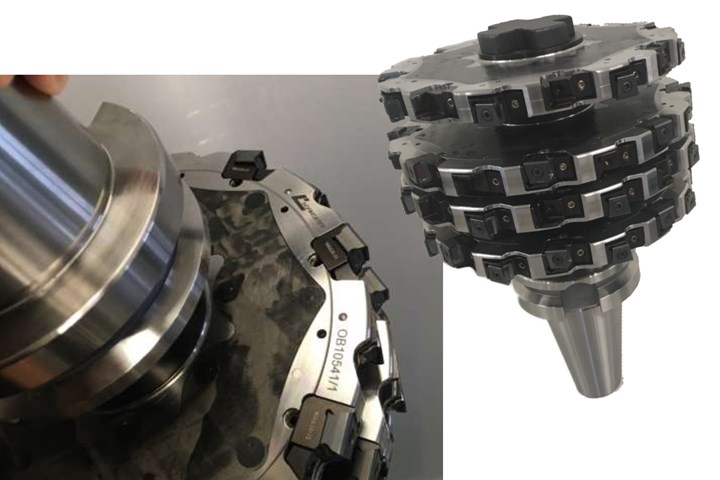Hybrid metal composite four-disc milling cutter reduces machining times by 78%
CompoTech and Hofmeister steel and carbon fiber tool achieves 50% faster cutting speed and 54% higher feed rate compared to conventional two-disc tools.

Photo Credit: Hofmeister
CompoTech Plus spol. s r.o. (Sušice, Czech Republic) announced on Jan. 20 that it has developed a new next-generation hybrid steel and carbon fiber (CF) composite milling cutting disc in collaboration with Hofmeister Innovation (Pilsen, Czech Republic). Increasing both conventional cutting speed and feed rate in overall machine time, the hybrid milling tool can reportedly operate 78% faster on the same milling center than a standard steel two-disc cutter.
The tool design uses a lightweight epoxy composite reinforced with ultra-high modulus carbon fibers for the inner section of the individual milling discs. The proprietary continuous fiber manufacturing process developed by CompoTech enabled the production of fully integrated hybrid milling discs with an outer band of 16 metal cutting inserts, for a total of 64. The CF section is integrated with the steel hub and ring using a combination of an interlocking shape design and steel bolts.
The semi-finished CF composite components for the hybrid discs were produced and assembled by CompoTech using semi-finished steel components supplied by Hofmeister, which performed the final machining of each hybrid cutting disc and assembly of the complete hybrid milling tool. The entire four-disc hybrid milling cutter weighs only 16.25 kg.
According to CompoTech, key production benefits include a reduced moment of inertia, resulting in lower energy consumption; reduced thermal-mechanical load on milling machines; improved anti-vibration damping properties, increasing slot hole machining accuracy; smoother machine operation for a higher quality surface finish; and significantly increased output rates, productivity and reduced production costs. Business benefits from using the new hybrid tool include debottlenecking, improving profitability and delaying or avoiding the need for further capital investment to achieve growth targets.
Test milling was carried out on a forged, high-strength steel connecting link using a Doosan Mecatec HM63H machining center. Accurate cutting to tolerance the side and the bottom faces of the forged link was completed in 10 seconds using the new hybrid milling cutter, 35 seconds faster than a conventional two-disc metal tool.
Measurements made on the Vc and Vf rates for both types of milling tools (four-disc hybrid and two-disc metal) showed that the hybrid CF four-disc milling cutter has a 50% faster cutting speed and a 54% higher feed rate. Tool life durability data was also gathered, which recorded approximately 250 pieces machined before a tool change for the two-disc milling cutter, compared with more than 1,200 parts (>4.8 times more) produced using the hybrid four-disc tool.
The comparative testing carried out during the project (the table can be found here) also conclusively demonstrated that the hybrid four-disc milling tool can be used for machining in precisely the same way as a conventional all-metal two disc milling cutter, but with added machining speed and durability. These benefits are said to justify the initial higher cost of the new hybrid cutter, which Hofmeister has estimated has an investment payback period of only around three months for a high-volume producer.
Related Content
-
Optimizing a thermoplastic composite helicopter door hinge
9T Labs used Additive Fusion Technology to iterate CFRTP designs, fully exploit continuous fiber printing and outperform stainless steel and black metal designs in failure load and weight.
-
Improving carbon fiber SMC simulation for aerospace parts
Simutence and Engenuity demonstrate a virtual process chain enabling evaluation of process-induced fiber orientations for improved structural simulation and failure load prediction of a composite wing rib.
-
ATLAM combines composite tape laying, large-scale thermoplastic 3D printing in one printhead
CEAD, GKN Aerospace Deutschland and TU Munich enable additive manufacturing of large composite tools and parts with low CTE and high mechanical properties.















